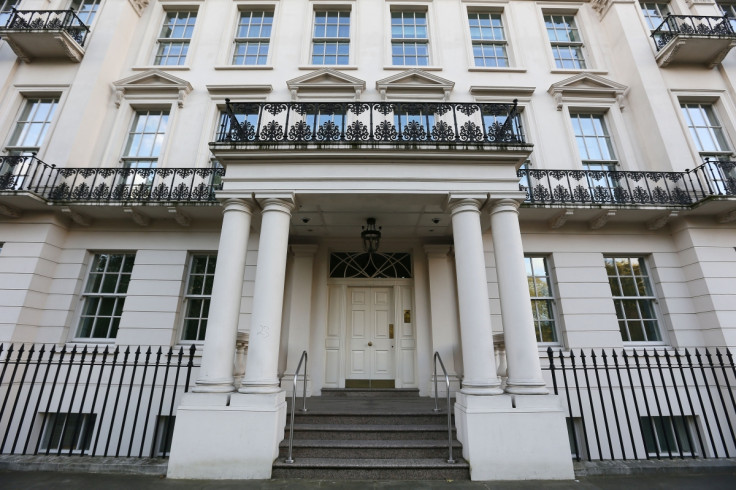Is Central London's Hot Property Market About to Cool Down?

If you were to only look at investment in London's high-end property market you might never have guessed the world went through one of history's biggest financial meltdowns just a few short years ago.
Arab princelings drink in the bars of Chelsea from the ever-flowing fountain of oil money in their Middle Eastern realms, away from the Mullahs' judging eyes back home. Russian oligarchs do shady business at lunch in the West End's darkened private dining rooms.
Grinning heirs and heiresses clink wine glasses against their piano-key teeth over yahs and has in the cafes of Sloane Square. The City of London's investment bankers skulk in the narrow streets' shadows, making their way back to the penthouse flat after a night out with clients in Shoreditch gentleman's clubs.
These are the people of 'prime central London', property market jargon for the English capital's poshest, most expensive areas. It includes, but is not limited to, Belgravia, Mayfair, Notting Hill and Islington.
They are the areas where the world's wealthiest buy homes, even if not to live there themselves. Just 27% of foreign investors in prime London property during 2012 lived in it, according to business group London First. Some 58% rented out the property.
The moneyed minority have dominated certain areas of London for years, but now even the bottom end of the top – those who can afford a Ferrari 458, but not a Bugatti Veyron – don't have enough wealth to buy or rent there anymore.
"There is certainly evidence that boroughs outside of the classic prime areas such as Kensington and Chelsea and Westminster are now seeing strong rates of house price growth," said Matthew Pointon, property economist at Capital Economics.
"Indeed, with prices in the classic prime boroughs now looking expensive even for the wealthy, investors and overseas buyers will be looking for better value elsewhere, for example in areas such as Hammersmith & Fulham, Lambeth and Hackney."
Safe Haven
Prime London property is seen as a recession-proof asset. While the rest of the UK housing market suffered collapse in prices after the financial crisis, London raced ahead. Prices in prime London are 27% above their pre-crisis peak.
Investors were attracted to London at a time of international financial crises because the property market is deemed a 'safe haven'.
Amid political instability in the Middle East; the collapsing value of sovereign debt across Europe; crumbling banks on the subprime mortgage-backed asset fault line rocked by the seismic ripples of defaulting consumers – London property shone like a lighthouse guiding money to the safety of her shores.
...many domestic buyers relying on mortgages have been priced out of prime areas...
Sharply rising prices in prime London force wealthy people out from the middle. This overspill into the suburbs pushes others further out because they can't afford to stay as rents and house prices rocket.
"As prime London property prices have risen faster than UK incomes in the past years and overseas buyers are typically cash funded, many domestic buyers relying on mortgages have been priced out of prime areas," said Simon Khalil of Khalil & Kane ltd, a London-based firm that specialises in advice on buying high-end property in the city.
"As the mortgage market recovers and the UK economy in general recovers, more domestic buyers will return to the market, but purchasing in suburbs and fringe locations where they can afford to buy. As such prices will rise in such areas, in the absence of any dramatic financial or political events in the near future."
Is the demand that's driving this sharp increase in property prices sustainable?
"Prices in the prime markets are dominated by domestic buyers, such as in Barnes, Wandsworth and Islington, and have been rising at a much faster rate than central London markets such as Kensington and Knightsbridge," said Susan Emmett, director of residential research at the estate agency Savills.
"Yet so far we have seen very little of London's substantial growth in property prices trickle out. We think this could change in 2014.
"The markets away from the centre are due a catch up. That is why we are forecasting price rises of 26% in prime suburbs and 25% in inner commute areas compared with 23% in prime central London over the next five years."
It appears this pick up is already starting. Official figures from Land Registry show that at the end of 2013, the London borough with the fastest annual rate of price growth was Waltham Forest at 15.3%. Not far behind is Wandsworth at 13.8%. Slower growth can be seen in the City of Westminster at 9.8% and Kensington and Chelsea at 9.2%.
Tax, Recovery and Oversupply
However, there are three main threats to demand that could trigger a painful unwinding in prices. The first is taxation, the second is the global economic recovery, and the third is oversupply.
Chancellor George Osborne has already sent a jitter down investors' spines by imposing the capital gains tax on foreign owners of property in London, something that was not previously levied on them and thus was an attractive feature of the market.
Uncertainty surrounding this leading up to the next general election in spring next year will help keep a lid on demand for prime property
Two of the three main political parties in the UK – Labour and the Liberal Democrats – back a "mansion tax" on properties worth over £2m. There is a serious chance that Labour will win an outright majority at the 2015 general election, or that they will at least form a coalition government with the Lib Dems. And that must be weighing on investors' minds.
"In the shorter term, price growth in PCL should slow particularly in the run-up to the election in 2015 as potential buyers wait to see what happens to the tax regime," said Savills' Emmett.
"Assuming there is no further changes to the taxation of high value property, price growth should rebound."
Pointon of Capital Economics said a mansion tax would "have a large impact on capital values".
"Uncertainty surrounding this leading up to the next general election in spring next year will help keep a lid on demand for prime property," he added.
"Demand for prime London property will continue to be supported by foreign demand for what is seen as a safe asset with relatively good returns.
"Of course, this 'safe haven' demand can quickly go into reverse as and when global economic conditions improve."
The global economy is already improving. The International Monetary Fund (IMF) upgraded its 2014 global growth forecast slightly 3.7%. Europe appears to be in recovery mode, albeit imbalanced between different countries and slow. The US recovery has some serious momentum and powerhouse Asia, having sparked fears with slowing economic growth, is picking back up again.
All of this may mean that there is less need for investors to hold their money in prime London property. They may find better returns elsewhere with a palette whetted for risk, such as in high-yielding European sovereign debt or emerging markets.
"London's reputation as a business and cultural centre will not diminish overnight," said Khalil.
"As a result, the main downside demand pressures for prime London property will be if sterling appreciates significantly, eliminating discounts for overseas buyers who make up a significant portion of this market segment; there are dramatic amendments to the tax treatment of overseas individuals; and a general global economic recovery and political stability in regions such as the Middle East may also lead to slower growth as there would be a less dramatic flight of buyers to London."
In 2013, Savills research shows that £7bn of foreign investment flooded into the prime London market. At the higher end of this, in the £1,000-£2,000 per square foot (psf) category dominated by foreign investors looking to make money, the current pipeline of building developments matches demand levels.
Therefore, Savills has questioned if all of the new developments can justify the price premiums attached. It is a precarious position. If demand falls away, so will prices. If supply rises any higher, prices will fall.
The "real test" is if people will be willing to pay the rents attached to these homes and so deliver the returns investors have been
Above this are the super-prime people, those with ultra-high net worth who can afford to spend £5m on a two bedroom flat. Savills says London is still the place of choice for the sort of "trophy home" these people seek out and that demand is robust right at the top of the market.

Emmett of Savills said she doesn't expect investors to lose interest in London, rather they will set their sights on property with lower values – in prices brackets below £1,000psf – where there is more growth potential and so bigger margins to be had.
"There is still a huge imbalance between supply and demand. We think London needs 50,000 new homes a year," she said.
"As it stands, the current pipeline should deliver an average of 28,500 new homes a year over the next five years. That leaves a shortfall of 21,500 homes.
"Most of that shortfall is at the bottom of the market. Given that 70% of London households earn £50K or less a year, this is also where the bulk of demand lies."
She concluded: "So far there is enough demand for homes priced between £1,000psf and £2,000psf to justify the current supply. But there is a risk of oversupply if this pipeline increases further or if current levels of demand fall away."
The coming year will be a pause for breath in the London property market. According to London Central Portfolio, investment advisers on buying property in the city, prime central London property prices rose 12.5% in 2013. This, they say, will slow sharply to 5.5% in 2014.
Investors will look at supply in some areas and doubt the price tags. They'll fret about the election and uncertainty over changes to the tax regime. They'll be tempted by the economic recovery emerging the world over, where returns may be better.
But will they actually take their money and leave? We're about to find out.
© Copyright IBTimes 2025. All rights reserved.






















